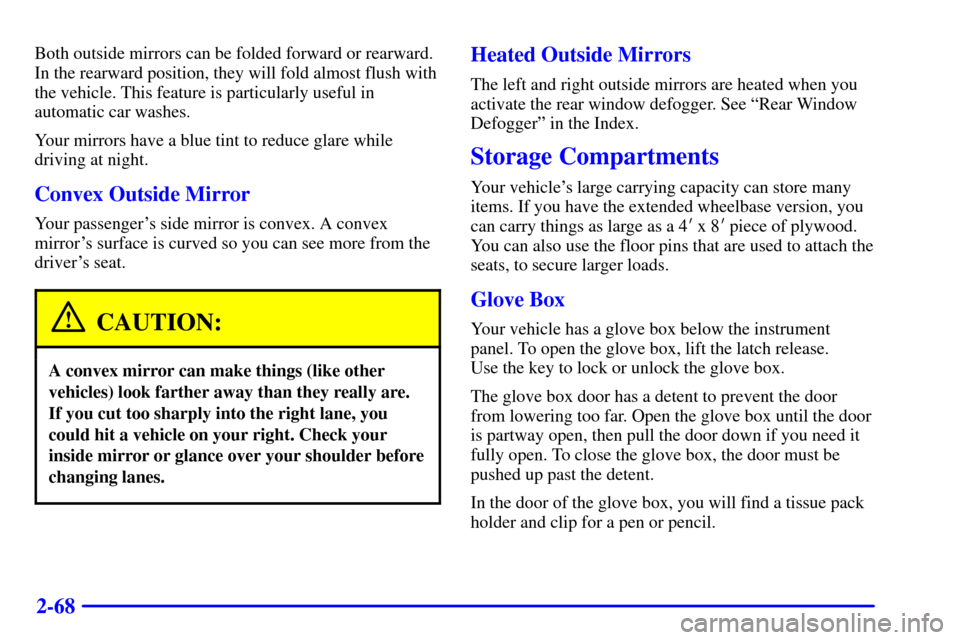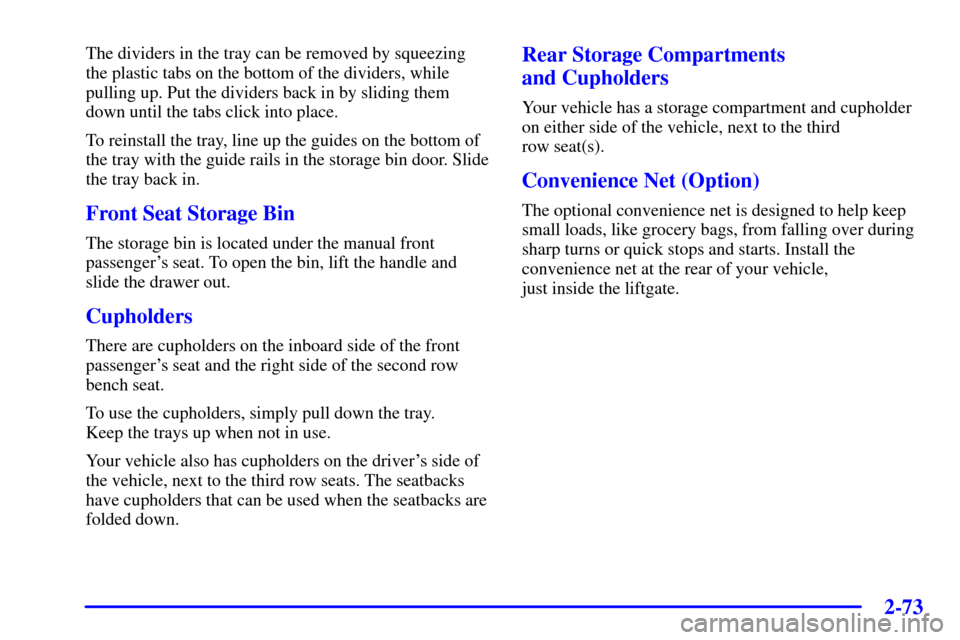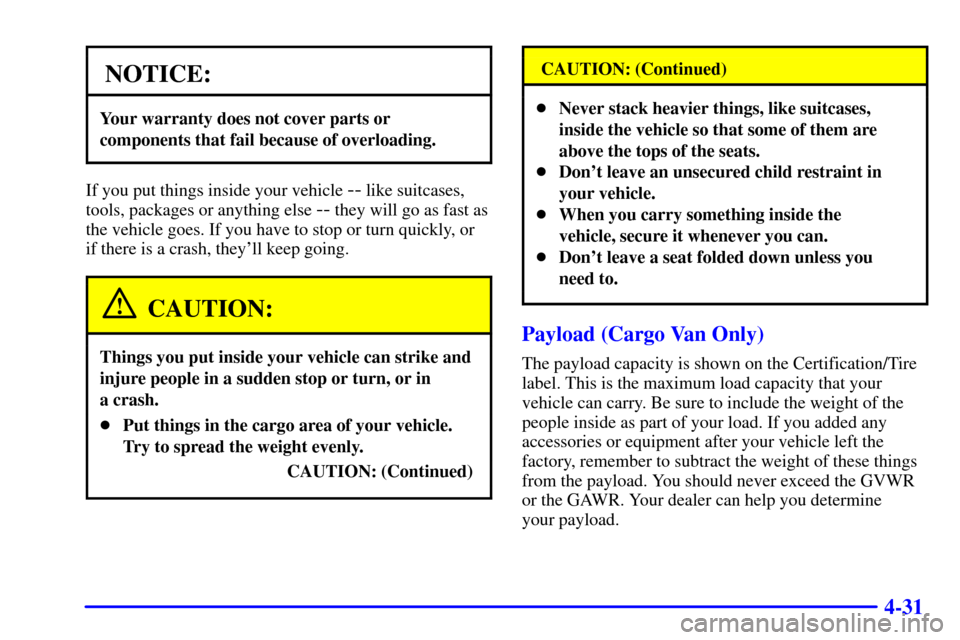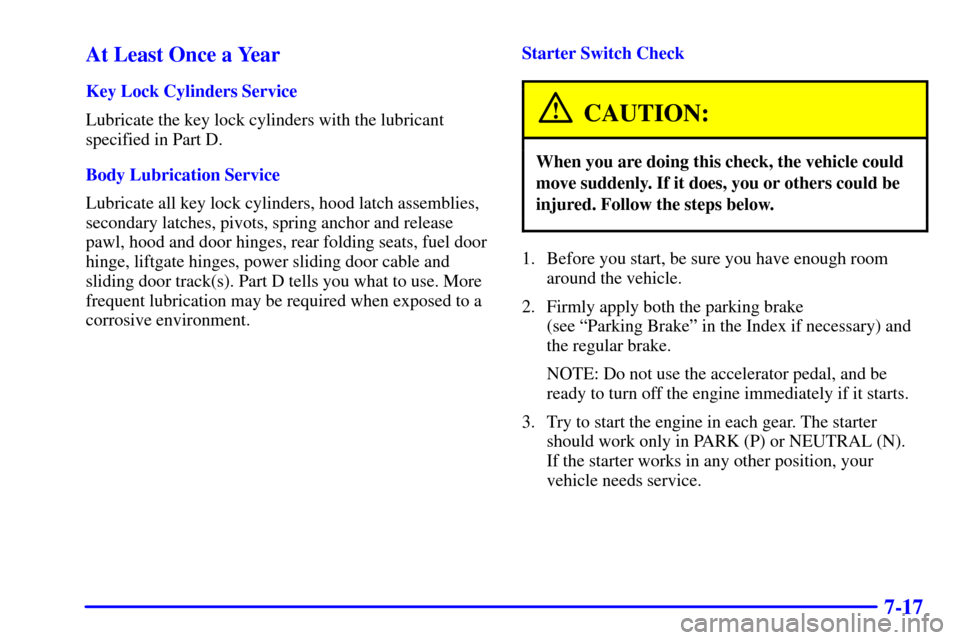Page 172 of 429

2-68
Both outside mirrors can be folded forward or rearward.
In the rearward position, they will fold almost flush with
the vehicle. This feature is particularly useful in
automatic car washes.
Your mirrors have a blue tint to reduce glare while
driving at night.
Convex Outside Mirror
Your passenger's side mirror is convex. A convex
mirror's surface is curved so you can see more from the
driver's seat.
CAUTION:
A convex mirror can make things (like other
vehicles) look farther away than they really are.
If you cut too sharply into the right lane, you
could hit a vehicle on your right. Check your
inside mirror or glance over your shoulder before
changing lanes.
Heated Outside Mirrors
The left and right outside mirrors are heated when you
activate the rear window defogger. See ªRear Window
Defoggerº in the Index.
Storage Compartments
Your vehicle's large carrying capacity can store many
items. If you have the extended wheelbase version, you
can carry things as large as a 4� x 8� piece of plywood.
You can also use the floor pins that are used to attach the
seats, to secure larger loads.
Glove Box
Your vehicle has a glove box below the instrument
panel. To open the glove box, lift the latch release.
Use the key to lock or unlock the glove box.
The glove box door has a detent to prevent the door
from lowering too far. Open the glove box until the door
is partway open, then pull the door down if you need it
fully open. To close the glove box, the door must be
pushed up past the detent.
In the door of the glove box, you will find a tissue pack
holder and clip for a pen or pencil.
Page 177 of 429

2-73
The dividers in the tray can be removed by squeezing
the plastic tabs on the bottom of the dividers, while
pulling up. Put the dividers back in by sliding them
down until the tabs click into place.
To reinstall the tray, line up the guides on the bottom of
the tray with the guide rails in the storage bin door. Slide
the tray back in.
Front Seat Storage Bin
The storage bin is located under the manual front
passenger's seat. To open the bin, lift the handle and
slide the drawer out.
Cupholders
There are cupholders on the inboard side of the front
passenger's seat and the right side of the second row
bench seat.
To use the cupholders, simply pull down the tray.
Keep the trays up when not in use.
Your vehicle also has cupholders on the driver's side of
the vehicle, next to the third row seats. The seatbacks
have cupholders that can be used when the seatbacks are
folded down.
Rear Storage Compartments
and Cupholders
Your vehicle has a storage compartment and cupholder
on either side of the vehicle, next to the third
row seat(s).
Convenience Net (Option)
The optional convenience net is designed to help keep
small loads, like grocery bags, from falling over during
sharp turns or quick stops and starts. Install the
convenience net at the rear of your vehicle,
just inside the liftgate.
Page 281 of 429

4-31
NOTICE:
Your warranty does not cover parts or
components that fail because of overloading.
If you put things inside your vehicle -- like suitcases,
tools, packages or anything else
-- they will go as fast as
the vehicle goes. If you have to stop or turn quickly, or
if there is a crash, they'll keep going.
CAUTION:
Things you put inside your vehicle can strike and
injure people in a sudden stop or turn, or in
a crash.
�Put things in the cargo area of your vehicle.
Try to spread the weight evenly.
CAUTION: (Continued)
CAUTION: (Continued)
�Never stack heavier things, like suitcases,
inside the vehicle so that some of them are
above the tops of the seats.
�Don't leave an unsecured child restraint in
your vehicle.
�When you carry something inside the
vehicle, secure it whenever you can.
�Don't leave a seat folded down unless you
need to.
Payload (Cargo Van Only)
The payload capacity is shown on the Certification/Tire
label. This is the maximum load capacity that your
vehicle can carry. Be sure to include the weight of the
people inside as part of your load. If you added any
accessories or equipment after your vehicle left the
factory, remember to subtract the weight of these things
from the payload. You should never exceed the GVWR
or the GAWR. Your dealer can help you determine
your payload.
Page 407 of 429

7-17 At Least Once a Year
Key Lock Cylinders Service
Lubricate the key lock cylinders with the lubricant
specified in Part D.
Body Lubrication Service
Lubricate all key lock cylinders, hood latch assemblies,
secondary latches, pivots, spring anchor and release
pawl, hood and door hinges, rear folding seats, fuel door
hinge, liftgate hinges, power sliding door cable and
sliding door track(s). Part D tells you what to use. More
frequent lubrication may be required when exposed to a
corrosive environment.Starter Switch Check
CAUTION:
When you are doing this check, the vehicle could
move suddenly. If it does, you or others could be
injured. Follow the steps below.
1. Before you start, be sure you have enough room
around the vehicle.
2. Firmly apply both the parking brake
(see ªParking Brakeº in the Index if necessary) and
the regular brake.
NOTE: Do not use the accelerator pedal, and be
ready to turn off the engine immediately if it starts.
3. Try to start the engine in each gear. The starter
should work only in PARK (P) or NEUTRAL (N).
If the starter works in any other position, your
vehicle needs service.